The tiny robobees being developed in the Microrobotics Lab of Wyss Institute core faculty member Rob Wood have a lot riding on their 3-cm wingspans. For starters, they may one day support dwindling bee populations by taking on pollination duties for billions of dollars worth of crops. And, as if that weren’t enough, they may also be charged with cultivating the next generation of scientists and engineers to ensure U.S. productivity, competitiveness, and security.
At least, that’s the thinking behind the educational outreach initiative taking place in the Wyss Institute’s Bioinspired Robotics platform. Ben Finio, a graduate student in Wood’s lab, has introduced these tiny robots to 24 schools in Boston and Cambridge since October 2009, for audiences ranging from fourth graders to high school seniors.

On Saturday, March 5, he joined forces with Radhika Nagpal and her Self-Organizing Systems Research Lab — bringing both arms of the Wyss platform together in this educational effort for the first time. The two performed demos, explained their work, and showed off their amazing collection of centipede, cockroach, bee, termite, and ant prototypes during “Insect Day” at Harvard’s Museum of Natural History.
Justin Werfel, a member of the Wyss Institute Advanced Technology Team, was also on hand to present “Robot Insects and Swarm Robotics,” a program highlighting the many ways in which researchers are drawing inspiration from insects to design swarms of robots for jobs in construction, exploration, and pollination.
Several more appearances are already in the pipeline: one at the Boston Museum of Science’s Robot Block Party on April 17, two at the Cambridge Science Festival on May 1 and 7, and one at the U.S. Science and Engineering Festival in Spring 2012. The events will feature Nagpal’s intrepid robot climbers whose pinwheel tires enable them to charge up and over a series of barriers. There will also be tables covered in robotic insects just waiting to be picked up and examined by curious youngsters.
“Robotics are an easy and fun way to get kids interested in science — it’s not like you’re trying to tell them about theoretical fluid dynamics or organic chemistry,” says Finio. “They tend to have this stereotypical image of a robot as some kind of killer from the Terminator movies, so seeing these new models is really educational and exciting.”
Finio’s kid-friendly presentation starts by delineating the first critical challenge in building these miniature machines — finding equally miniature tools and materials with which to do the construction. Using a regular screwdriver to tighten one of its screws would be a bit like using a snow shovel to put sugar in a cup of coffee. The next issue is finding a way to make one of these tiny machines move without strapping on a AA battery at approximately 400 times its weight.
Finio and Wood focus their research on these engineering aspects, working closely with biologists to replicate the precise vein system in a bee wing and to reverse engineer the muscle in a centipede leg. Meanwhile, Nagpal and Werfel gravitate toward the computer science aspect, such as determining how to make these not-very-bright, toy parts coordinate as a team to accomplish tasks in much the same way as worker bees act collectively to groom and feed the queen.
These robotic insects may one day have important societal applications as well. For instance, swarms of robotic centipedes, equipped with tiny cameras or thermal sensors, may be able to tunnel into earthquake debris and transmit life-saving information about any survivors buried in the rubble. Some may even be able to fan out in war zones and hone in on buried explosives.
But for now, they are performing meaningful service in elementary schools and science museums throughout Boston — as evidenced by the feedback the team receives. One middle-school student summed it up best, writing: “Thank you for showing us the robot. I am going to build my own and maybe I could show you!” Videos of the robots in action are available on the Harvard Microrobotic Lab’s YouTube channel.